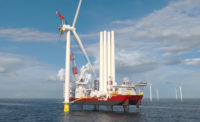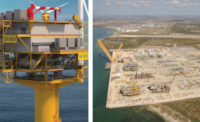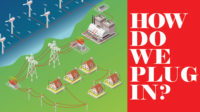
Eric Hines
In September, the first barge with large wind turbine components finally left the New Bedford Marine Commerce Terminal in Massachusetts for installation on the Vineyard Wind 1 offshore wind farm. This milestone for America’s first industrial scale project has been anticipated since signing of its state power purchase agreement five years ago.
The project’s 62 giant GE turbines, each able to generate 13 MW of clean power, for a total of 800 MW, are among the largest that will operate in the Atlantic.
They are nearly four times more powerful than those previously planned for the assembly site’s ill-fated first project, Cape Wind—which faced strong local opposition and then lost its financing and power contract at the end of 2014.
For those who had raced to complete the assembly terminal almost ten years ago, now seeing those components finally depart to a real ocean location far from shore was a moment of celebration and relief.
Just days before, the world’s largest offshore wind developer announced the potential for a $2.3-billion impairment charge due to a “litany of problems in its US projects,” which it said caused a loss of “more than $8 billion in market value.”
Indications of such problems began to surface a year ago when another Massachusetts wind project developer told the market that a host of issues—from the Ukraine War and inflation to interest rates and supply chain bumps—would affect power prices it had previously negotiated with state utilities. This developer eventually pulled its bid, as did another that secured a Massachusetts power purchase agreement.
Both projects are said to be preparing new bids—at higher prices—for the state’s next wind solicitation round in early 2024. Originally, this news seemed to indicate that Massachusetts may have been overzealous with its 2016 “price cap.” Soon after, however, similar cost upheavals were seen on projects in New York and New Jersey.

Barbara Kates-Garnick
'Shining Light' on Energy Transition
Massive wind turbines, constructed far offshore to capture some of the world’s most reliable wind, have emerged as the renewable energy of choice for densely populated East Coast states. This new industry has demonstrated an uncanny ability to shine light on issues that are critical to the larger U.S. energy transition such as transmission, long-term investments and collaboration among diverse stakeholders.
As a result, states committed to achieving ambitious and looming decarbonization goals have fiercely competed to claim leadership on climate action and secure first-mover advantage through a wide range of procurement processes. In early 2022, we determined that the present value difference between the levelized nominal price of the least expensive project in Massachusetts and the most expensive project in New York was 56%, revealing a lack of consistent language for pricing, forward capacity markets and economic benefits.
In January 2015, U.S. offshore wind lease areas in Massachusetts and Rhode Island sold for about $1 per acre. By February 2022, similar lease areas in the New York Bight sold for close to $10,000 per acre. Combined with the 25-fold increase in state commitments to procure offshore wind over five years between 2016 and 2021, offshore wind’s momentum has gathered faster than anyone could have predicted. That should give us hope that we have a fighting chance against the climate crisis—and it should reassure us that now is the time to invest.
"We need to build offshore wind's underwater infrastructure to last, like our bridges, tunnels, dams and transmission lines—not as a commodity to be decommissioned and replaced in 25 years like the turbines themselves."
—Eric Hines and Barbara Kates-Garnick
We need factories, workforce, ports and wind turbine installation vessels. We need a plan for our future transmission system, which must triple in size and requires action within and across all regions of the US. We need a transparent procurement process that does not leave critical details related to price and cost burrowed in proprietary and arcane regulatory filings.
We need clear rules of competition that the private sector can rely on—is each new project about lowering the cost of energy or about investing in future economic benefits?
We need a well-coordinated regulatory process that can satisfy the interests of federal, Tribal Nation, regional, state and local jurisdictions. We need to build offshore wind’s underwater infrastructure to last like our bridges, tunnels, dams, and transmission lines—not as a commodity to be decommissioned and replaced in 25 years like the turbines themselves.
'Getting Serious'
Over 3,000 MW of US projects are underway this year, federal commitments are strong and there is a growing interest among state decisionmakers, utilities and developers to consider needed regional initiatives. These trends indicate that after 20 years of dramatic ups and downs, this industry is finally getting serious.
The present market adjustment and historic alignment of public and private interests offer an opportunity to advance the future transmission system faster than anyone thought possible.
Offshore wind’s dual tendency to highlight critical needs and shatter expectations has shown itself more than once. Like our other infrastructure, American offshore wind energy needs large-scale, long-term investments in which both public and private sectors play a role.
The significance of this moment is that the decisions made today are fundamental to a future where offshore wind achieves its energy and environmental promise.
Eric Hines, PhD, PE, directs the offshore wind graduate program in the School of Engineering at Tufts University in Medford, Mass., and Barbara Kates-Garnick, PhD, is a professor of the practice at the Fletcher School of Law and Diplomacy there. They can be reached at Eric.Hines@tufts.edu and Barbara.Kates_Garnick@tufts.edu, respectively.




